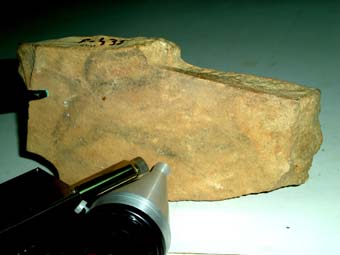
A team of scientists of the Institute of Material Sciences (ICMUV) and the Department of Prehistory and Archaeology of the University of Valencia have made the first characterization of pigment of the tiles of the Cova Parpalló of Gandia, an important collection in a European level for the volume of material that it has and the period of time which covers, more than 10.000 years. Through nondestructive techniques the researchers have shown that the black colors of the painting were obtained at Paleolithic with coal and soil with manganese oxide.
The findings of the prehistoric site of the Cova Parpalló, one of the most important of the peninsula, consists of cravings and paintings in more of 5.000 tiles and show cultural expressions of the hunter-gatherers communities of the Upper Paleolithic in the Peninsular Mediterranean fringe. To analyze the pictorial materials, which were made with a palette of basic colors (black, red and yellow) the scientists used portable nondestructive techniques, such as spectrocolorimetry and spectrometry EDXRF, in order to avoid deterioration of pigments and study and monitor the temporal evolution of its chromatic coordinates and contribute to its conservation. “In first place, we studied the black colors of the painting to make its first characterization, what has shown a high proportion of figurative motifs, made with charcoal, using black manganese and the absence of pigments based in black of calcined bone”, explains Professor Clodoaldo Roldán of the ICMUV, located in the Science Park of the University of Valencia.
The long temporal sequence of the Parpalló collection is unique establishing the characteristics of the Paleolithic art of southwestern Europe, especially in the periods corresponding to the Solutrean, and this has clarified the idea of a linear evolution of the Paleolithic art, at the same time has helped to define the importance of studying the cultural processes of regional nature. “The results obtained confirm that in this site were used the same techniques and colors that have been identified so far in the parietal analysis of figures painted in the same timeline. This coincidence results very interesting because it is an argument in favor of the similarity of the procedures used in Paleolithic parietal art”, says Roldán. The type of coloring matter used in the tiles of Parpalló has been documented in other wall sets paintings of the Pre-Magdalenian period; such is the case of Pech Merle (Cabrerets, France) or the Cueva de la Pileta (Benaojan, Malaga).
The work has been divided into three phases: acquisition of experimental data, which was carried out in situ in the Museum of Prehistory of Valencia (guardian of the collection) during 2011; the analysis of experimental data and drawing conclusions referring to black pigments, during 2012; and the study of experimental data referring to red and yellow pigments, which is now under way.
The Group of Archaeometry of the ICMUV and the Research Group of Quaternary Archaeology of the Department of Prehistory and Archaeology, led by the Professor Valentin Villaverde, are focusing on researches on the Middle and Upper Palaeolithic of the Spanish Mediterranean. The objectives of these studies are among others, the characterization of raw materials and its management systems, the definition of lithic and bones chains and characterizations of the coloring found in the sites and the processes related with its use in, walls, body or objects decoration.
TECHNOLOGY FOR ART
Moreover, the same team of researchers of the ICMUV of the University of Valencia, led by Clodoaldo Roldán has also published in the journal Radiation Physics and Chemistry the results of the analysis of the Triptych of Pentecosta (XVI century) of the Church of Sao Pedro Miragaia of Oporto. This last work, as indicates the scientist, is a clear example of interdisciplinary collaboration: “the portability of the spectrometers EDXRF, together with non-destructive techniques are an excellent support tool for art restorers”. In the present case, restoration work has involved an intervention strategy compatible with the pictorial matters identified in original areas (calcium carbonate, lead white, red and yellow ocher, vermilion red, and blue and green based on copper compounds) and the ones identified in restorations carried out in the early XX century (chrome green, cobalt blue, cadmium red and white zinc).
More information:
www.uv.es/cdciencia
Last update: 21 de january de 2013 07:00.
News release



















